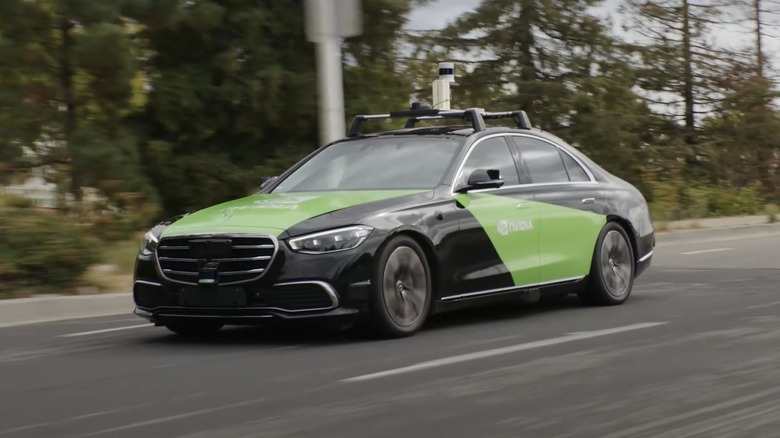How NVIDIA Is Helping Develop Self Driving Tech
NVIDIA is perhaps best known for its gaming GPUs with its RTX GPUs among the most powerful and popular on the market. However, the company has been diversifying its product portfolio for a number of years now. It tried its hand at Tegra Arm-based mobile SoCs for a while, although about the only place you will find a Tegra SoC in a mainstream product these days is in the Nintendo Switch. That hasn't affected its ambitions with Arm-based silicon, however, as evidenced by the company's recent bid to acquire Arm outright. While that deal fell through due to regulatory concerns, the company has been making some very powerful Arm-based silicon for data centers as well as for use in cars.
The NVIDIA DRIVE Hyperion platform leverages its expertise in silicon design as well as graphics, AI, and cloud computing to deliver an end-to-end full for powering the semi-autonomous on the road now and the fully autonomous cars of the near future. The company recently demoed its wares at its GTC 2022 AI conference for developers. With car makers like Mercedes-Benz, Jaguar, Volvo, Hyundai, BYD, Lucid, and Nio on board, there is a good chance that you may find yourself in a car powered by NVIDIA technology soon.
NVIDIA's Arm-based silicon is driving its autonomous future
NVIDIA calls its DRIVE Hyperion platform both "production-ready" and designed for autonomous vehicles. It combines an NVIDIA Arm-based Orin AI compute module with a sensor suite made up of 12 exterior cameras, three interior cameras, nine radars, 12 ultrasonic sensors, one front-facing lidar and one lidar for ground truth data collection. The NVIDIA DRIVE Orin SoC performs at 254 trillion operations per second (254 TOPS) and can be scaled from Level 2+ autonomous car systems right through to Level 5, according to the company.
But it's the next-generation NVIDIA Drive Atlan SoC that looks to be particularly exciting and will power next-generation autonomous cars in the near future. It will be powered by an Arm-based NVIDIA CPU using the company's Grace architecture coupled with an integrated NVIDIA Ada Lovelace-based GPU, which is the same GPU tech that will be powering NVIDIA's next-generation RTX 40-series gaming GPUs. When the NVIDIA Drive Atlan system arrives in 2023, it will deliver over 1,000 trillion operations per second and will be ready for car makers' 2025 MY cars. With the massive amount of sensor data that is needed to safely power autonomous cars, this is exactly the kind of hardware that is needed to deliver a future where a fully autonomous car can get us to our destination without needing to touch a steering wheel.
Hardware is nothing without software
The silicon embedded in vehicles is only one part of a multi-pronged solution that NVIDIA has developed for car makers with autonomous ambitions. DRIVE OS is the onboard software that powers NVIDIA's Orin compute module as well as the future Atlan SoC. It also interfaces with Blackberry QNX systems that continue to be popular with many car makers. DRIVE OS integrates with DriveWorks and DRIVE AV that combine deep neural network frameworks and mapping layers to support cars with autonomous functionality to navigate through traffic and other hazards with minimal driver intervention.
NVIDIA is also developing its own voice-activated smart car assistant to help ensure the in-car experience is as seamless as its autonomous driving experience. The company currently has two AI smart assistants to support the in-car experience: DRIVE Concierge and DRIVE Chauffeur. Drive Concierge uses a fun avatar to assist with recommendations, control vehicle functions like climate, provide alerts, or even book reservations at restaurants or the movies. As you might have guessed, DRIVE Chauffeur is an AI-powered voice-controlled navigation system that is tightly integrated with NVIDIA's Orin silicon and software to both get you from A to B, but to also ensure that you safely navigate the environment and potential hazards around you with the DRIVE systems doing all the work.
NVIDIA's working with autonomous cars from all angles
As you might have guessed by now, NVIDIA is all-in when it comes to creating a complete solution for autonomous car makers. But its model doesn't stop at silicon, software, or AI technology in its various forms, it also includes a complete cloud-powered backend to support OEMs that it calls DRIVE Infrastructure. The system is designed around high-performance AI computing servers powered by NVIDIA server CPU and GPU silicon that can be used to analyze real-world system performance and continually improve vehicle intelligence. This can eventually work its way into cars on the road through over-the-air (OTA) updates.
NVIDIA even takes autonomous car development to another level using software it calls DRIVE SIM, which recreates real-world traffic scenarios in a virtual environment that allows virtual autonomous vehicles to be tested in complete safety without the need for deployment of real cars in real-world scenarios. This can give car makers much greater confidence about the reliability of their systems before they are fitted to production-ready models for further testing. The modularity of NVIDIA's systems is arguably its greatest strength. Car makers can join NVIDIA and go all-in together using its full end-to-end offerings, or they can just use elements from NVIDIA's DRIVE package that they require. Apple might be getting all the headlines around autonomous car technology, but there is a high likelihood that NVIDIA's autonomous car tech will power many more cars on the road.
